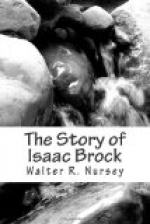[Illustration: PLAN OF BATTLE OF QUEENSTON]
The United States troops, which had been heavily reinforced, consisted at this time of about one thousand fighting men, on and about the mountain. This number was slowly supplemented by fresh arrivals from Lewiston, encouraged when they saw the American flag planted on the redan. The wounded were sent across the river. Nearly all of the new arrivals were regulars. Colonel Winfield Scott, of Mexican fame, a tried soldier, six feet four in his stockings, was now in command, supported by a second field-piece and many sharp-shooters. Van Rensselaer, narrowly escaping capture, had retreated by boat to Lewiston, ostensibly to bring over more troops. Finding the conditions unfavourable, he did not do so, but sent over General Wadsworth, as a vicarious sacrifice, to take command. The gun in the redan had been unspiked, and the summit strongly entrenched, but as Scott’s men betrayed strange lukewarmness, orders were given “to shoot any man leaving his post.”
Sheaffe’s men having rested after their forced tramp, a few spherical case-shot by Holcroft drove out the American riflemen. His gunners had at last silenced the Lewiston batteries, and finding the river range, sunk almost every boat that attempted to cross. The Indians were now ordered to drive in the enemy’s pickets slowly. Scouting the woods, they routed his outposts.
About four p.m. Captain Bullock, with two flank companies of militia and 150 men of the 41st, advanced, and after firing a volley in the face of a dense smoke, charged the enemy’s right, which broke in great confusion. A general advance was ordered, and, with wild warwhoops by the Indians and white men, the heights were rushed, Wadsworth’s veterans were stampeded, the redan retaken at the point of the bayonet, and Scott’s command forced to the scarp of the cliff overhanging the river.
The American soldiers, to quote United States historians, now “fled like sheep,” and scuttled off in all directions. Some raced headlong down the main road, seeking shelter under the muzzles of Holcroft’s guns; some sought refuge in the houses; others raced to the landing only to find the boats no longer there. Not a few, hot pressed by Brant’s avenging Mohawks, threw themselves over the precipice, preferring suicide to the redman’s tomahawk. Others plunged into the Niagara, essaying to swim its irresistible eddies, only to be blown out of the green water by Holcroft’s grapeshot or sucked down by the river’s silent whirlpools.
One boat, with fifty struggling refugees, sank with its entire crew. Two others similarly laden were beached below the village, with only one dozen out of one hundred souls still living. The river presented a shocking scene. On the face of the water men, many maimed and wounded, fought and struggled for survival. This pitiful spectacle was actually taking place under the eyes of several thousands of American soldiers on the Lewiston bank, who, almost impossible to believe, and to their lasting disgrace, refused to join, or attempt even to succour, their comrades—deaf to all entreaty—allowing them to perish. Every room and shack at Queenston was an improvised hospital or morgue, filled with the mangled bodies of the quick and dead.




